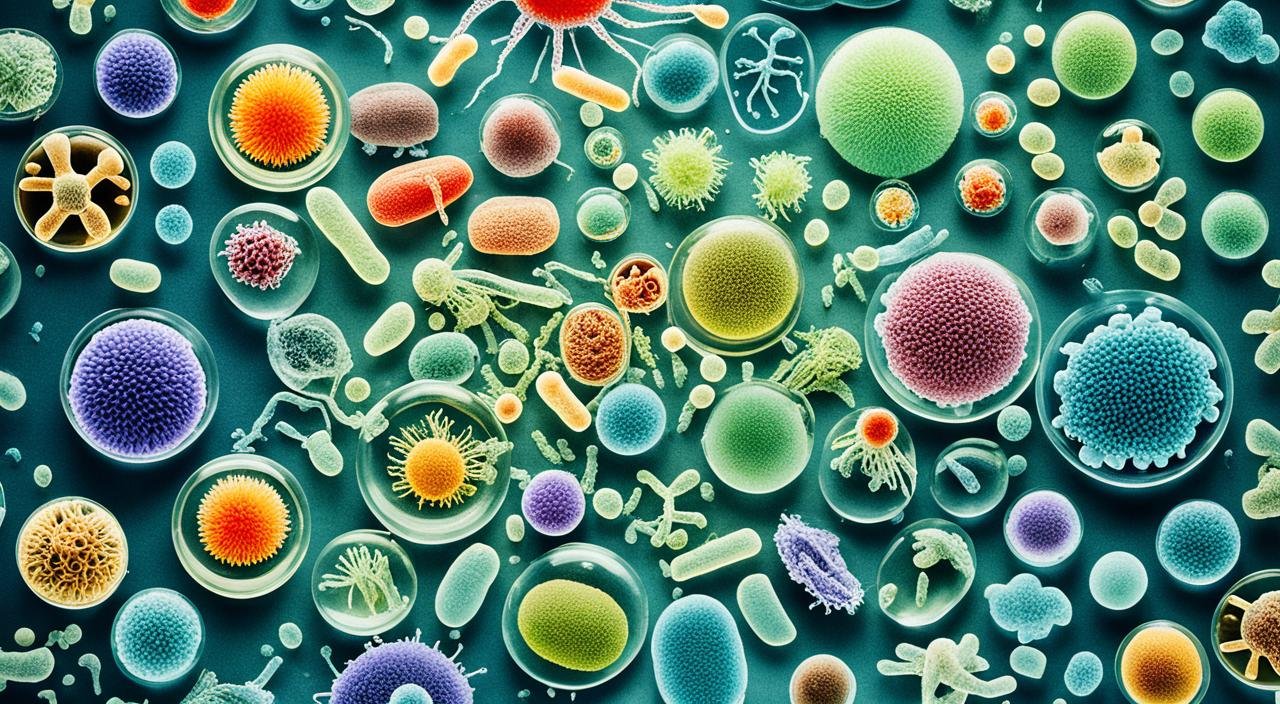Infectious diseases come from organisms like bacteria, viruses, and fungi. They can be passed from one person to another. This happens through touching, food, water, and the air. Illnesses like the flu, and COVID-19 count as infectious diseases. They are a big reason for deaths, especially in poor areas.
There are also other diseases like strep throat, and malaria, caused the same way. These illnesses don’t just harm health. They also make places poorer, and disrupt how people live.
Key Takeaways
- Infectious diseases are caused by pathogenic organisms such as bacteria, viruses, fungi, and parasites.
- These infectious agents can spread through direct contact, indirect contact, insect bites, or contaminated food and water.
- Common infectious diseases include influenza, COVID-19, strep throat, tuberculosis, ringworm, and malaria.
- Infectious diseases are a major global health concern, contributing to significant mortality and economic/social impacts.
- Understanding the causes and transmission modes of infectious diseases is crucial for developing effective prevention and control strategies.
Also Read : How Can STEM Education Benefit Students?
Introduction to Infectious Diseases
Infectious diseases are a big deal for global health, threatening people and communities around the world. They are caused by tiny germs like viruses, bacteria, fungi, and parasites. These germs can go from one person to another, from animals to humans, or through dirty food and water. It’s important to understand these diseases to fight them better.
Also Read : What Are The Basic Interview Techniques?
Overview of Infectious Diseases and Their Impact
Infectious diseases cause millions of deaths every year, hitting the most vulnerable the hardest. This includes the old, young, and those with weak immune systems. The problems from these diseases reach far, hurting individuals and messing up society and the economy. This infectious diseases overview shows how much they stress healthcare and society.
Difference Between Infectious and Non-Infectious Diseases
- Infectious diseases pass from one person to another through microorganisms, including zoonotic diseases.
- Non-infectious diseases don’t spread through external pathogens. Genetics, lifestyle, environment, and aging play a big part in them.
Knowing how infectious and non-infectious diseases differ is key. It helps in managing, preventing, and treating them the right way.
Also Read : What Are The Essential Nutrients For A Healthy Diet?
“Infectious diseases remain one of the leading causes of death worldwide, with the potential to spread rapidly and cause devastating outbreaks or even pandemics.”
| Characteristic | Infectious Diseases | Non-Infectious Diseases |
|---|---|---|
| Cause | Viral, bacterial, fungal, or parasitic pathogens | Genetic, environmental, and lifestyle factors |
| Transmission | Contagious, can spread from person to person or animal to person | Not contagious, cannot be transmitted from person to person |
| Examples | Influenza, HIV/AIDS, tuberculosis, malaria | Heart disease, cancer, Alzheimer’s disease, Parkinson’s disease |
Types of Infectious Diseases
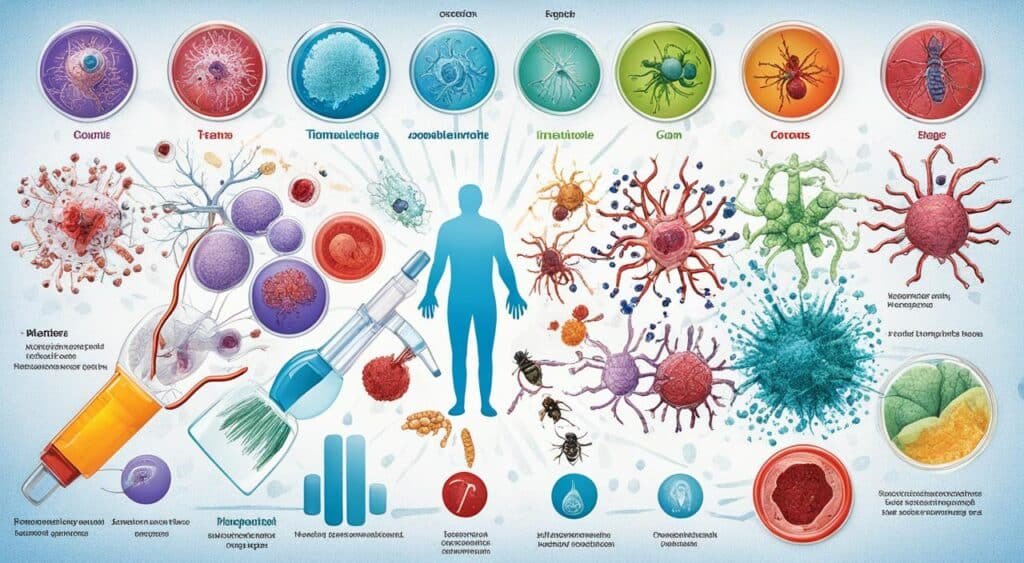
Infectious diseases come from various pathogens like viruses, bacteria, fungi, and parasites. It’s vital to know the kinds of infectious diseases for their prevention, treatment, and management. Now, we’ll dive into the main types.
Also Read : What Are The Best Exercises For A Daily Workout?
Viral Infections
Viruses cause viral infections, needing living cells to multiply. Common ones are influenza, HIV/AIDS, and the recent COVID-19 outbreak. These infections often spread easily through respiratory droplets, touch, or by touching contaminated surfaces.
Bacterial Infections
Bacterial infections are from single-celled bacteria. They can be as simple as a skin infection or as serious as tuberculosis and anthrax. Transmission can occur through food, water, touch, or in the air.
Also Read : How Can You Prevent Chikungunya ?
Fungal Infections
Fungi bring about fungal infections in people. A few examples are ringworm, candidiasis, and aspergillosis. These infections can target the skin, nails, and internal organs, causing big problems for those with weak immune systems.
Parasitic Infections
Parasites cause parasitic infections, needing another organism for food. Illnesses like malaria, toxoplasmosis, and giardiasis are included. Parasites spread through insect bites, food, water, or contact with infected individuals and animals.
Transmissible Spongiform Encephalopathies (TSEs) and Prion Diseases
TSEs or prion diseases are rare and caused by prions, abnormal proteins. They destroy brain tissues, causing severe symptoms. Examples are CJD and BSE, or “mad cow disease”.
Knowing the various infectious diseases is key for preventing and controlling them. Understanding each type helps in choosing the right treatment and management. It allows healthcare workers and the public to fight these diseases together.
Common Infectious Diseases
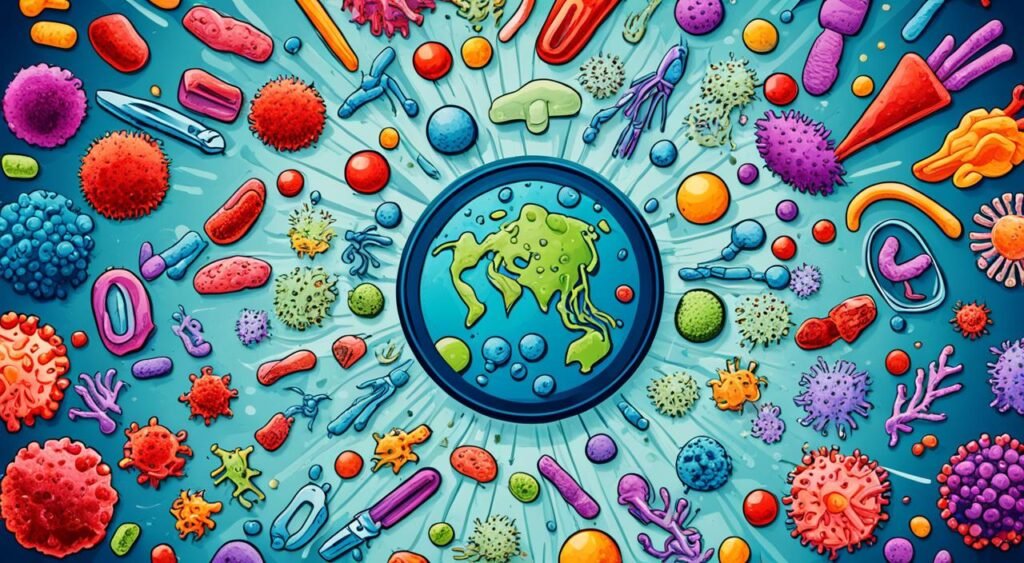
Infectious diseases are a big worry for public health, hitting millions worldwide. Types like viral, bacterial, fungal, and parasitic infections are common. Knowing about them helps prevent, spot early, and treat effectively.
Viral infections often cause the flu, common cold, hepatitis, and HIV/AIDS. They can be mild or dangerous. Bacterial infections are also common, like strep throat, pneumonia, and Lyme disease.
Fungal infections are less common but still troublesome, such as athlete’s foot and yeast infections. Parasitic diseases, including malaria and giardiasis, can be serious for some people or in certain places.
Many of these diseases can be stopped with vaccines, good hygiene, and safe food handling. Getting diagnosed early and treated right is key to managing symptoms and preventing spread.
| Infectious Disease | Causative Agent | Symptoms | Transmission |
|---|---|---|---|
| Influenza (Flu) | Influenza virus | Fever, cough, sore throat, body aches | Respiratory droplets, contact with contaminated surfaces |
| Common Cold | Rhinovirus, coronavirus | Runny nose, sneezing, sore throat, cough | Respiratory droplets, contact with contaminated surfaces |
| Strep Throat | Streptococcus bacteria | Sore throat, fever, swollen lymph nodes | Direct contact, respiratory droplets |
| Pneumonia | Bacteria, viruses, fungi | Cough, fever, difficulty breathing | Respiratory droplets, contact with contaminated surfaces |
These examples show how common infectious diseases have a big impact on our health. Ongoing research and better prevention and treatment are key.
Risk Factors for Infectious Diseases
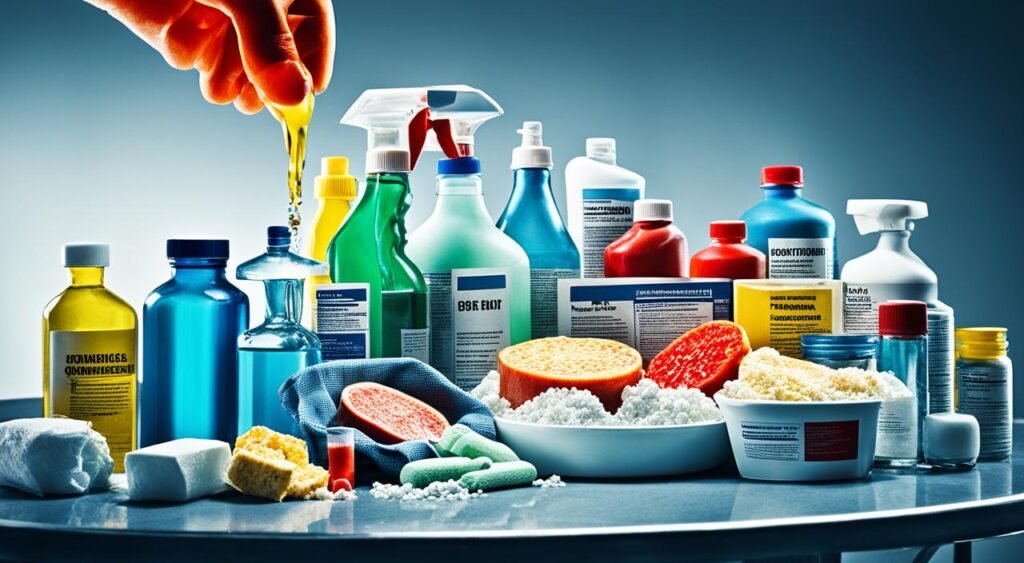
There are several ways people can become more likely to get infectious diseases. These include having a weak immune system, being very young or old, and working or traveling in certain places.
Weakened Immune System
Illnesses like cancer and HIV, as well as certain medicines, can weaken our immune systems. This makes it harder for our bodies to fight off germs and viruses, putting us at higher risk of getting sick.
Age and Vaccination Status
People at the very start or the end of their lives are more likely to get sick. Babies and children have immune systems that are still growing. Meanwhile, the elderly might not fight off illness as well. Not being vaccinated also makes it easier for diseases to spread in our bodies.
Occupational and Travel Risks
Some jobs, like those in healthcare, put us in contact with sick people or things. Traveling to places where diseases are common also raises our chances of getting sick. Without vaccines or other protections, we are more vulnerable.
| Risk Factor | Examples | Increased Susceptibility to |
|---|---|---|
| Weakened Immune System | Cancer, HIV/AIDS, certain medications | Viral, bacterial, fungal, and parasitic infections |
| Age | Infants, young children, elderly | Respiratory infections, vaccine-preventable diseases |
| Occupational Exposure | Healthcare workers, laboratory personnel | Bloodborne pathogens, respiratory infections |
| Travel Risks | Visiting regions with high disease prevalence | Tropical and endemic infectious diseases |
Knowing about these risks can help us stay safe. Taking precautions, like getting vaccinated or avoiding certain places, can lower our risk of catching infectious diseases.
“Strengthening the immune system and staying up-to-date on vaccinations are crucial steps in preventing infectious diseases.”
Transmission Modes of Infectious Diseases
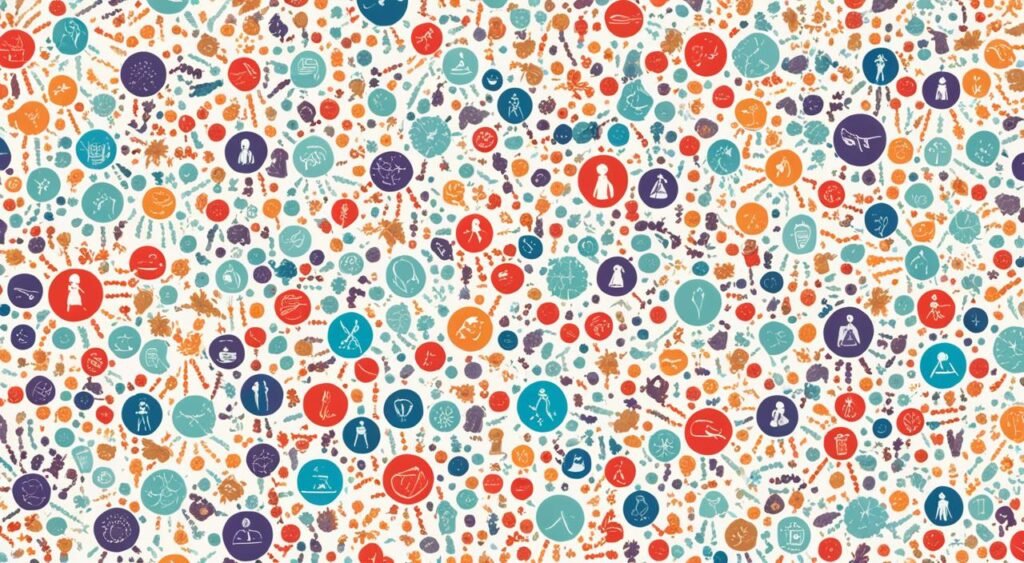
Infectious diseases have different ways to spread that we should know about. Each way needs its own special steps to prevent it. Knowing about these ways helps us stop the diseases from spreading.
Direct Contact
Direct contact is a common way for diseases to spread. This happens when one person touches the fluids of someone with the disease. It can be from kissing, sharing things, or touching surfaces.
Illnesses like the cold, flu, and hepatitis B spread this way.
Indirect Contact
Diseases can also spread when a sick person coughs or sneezes. The germs can land on things or be in the air. Then, when someone else touches that same spot or breathes in the air, they can get sick. Tuberculosis and measles are two diseases known to spread like this.
Insect Bites
Insects like mosquitoes and ticks can spread diseases by biting people. They feed on the blood of an infected person or animal. When they bite someone else, they pass on the disease. Malaria, Zika, and Lyme disease can spread through these bites.
Food and Water Contamination
Eating or drinking something with germs in it is another way to get sick. Salmonella and cholera are diseases that spread this way. It’s key to handle food and purify water correctly to avoid these illnesses.
Knowing how diseases spread helps us protect ourselves and others. We can do things to lower the risk of getting or spreading these illnesses.
“Controlling the spread of infectious diseases requires a comprehensive understanding of how they are transmitted.”
Infectious: Historical and Global Impact

Infectious diseases have shaped our past and present. For centuries, they have caused pain and turmoil worldwide. The Black Death in the 14th century and the more recent COVID-19 outbreak are good examples.
Pandemics and Epidemics in History
The Black Death, caused by the bubonic plague, killed millions in the 14th century. It changed societies in Europe, Asia, and North Africa. The Spanish Flu in 1918 was another dreadful pandemic. It took 50 million lives across the globe.
Recent events like the HIV/AIDS and the ongoing COVID-19 pandemic have also been severe. Over 32 million people have died from HIV/AIDS since the 1980s. COVID-19, starting in 2019, has heavily impacted the world.
Economic and Social Impacts
Infectious diseases hit our finances hard. They force businesses to close and people to stop traveling. The 2020 global recession, due to COVID-19, was the worst in a long time.
These diseases also change how we live and think. They can cause fear, disrupt schools, and even lead to political issues. Often, the poor suffer the most. For example, HIV/AIDS has worsened poverty in Africa.
| Infectious Disease | Historical Impact | Economic Impact | Social Impact |
|---|---|---|---|
| Black Death | Claimed up to 200 million lives in Eurasia and North Africa in the 14th century | Significant disruption to trade, agriculture, and economic systems | Led to social upheaval, political instability, and shifts in power structures |
| 1918 Influenza Pandemic | Estimated 50 million deaths worldwide | Disrupted economic activity and strained healthcare systems | Contributed to social unrest and political changes in the aftermath |
| HIV/AIDS Pandemic | Over 32 million deaths since the 1980s | Increased healthcare costs and lost productivity in affected regions | Increased stigma, disrupted families, and contributed to social and political instability |
| COVID-19 Pandemic | Ongoing, with over 6 million deaths worldwide as of 2023 | Global economic contraction of 3.1% in 2020, the worst recession since the Great Depression | Disrupted education, increased social isolation, and exacerbated existing inequalities |
The impact of infectious diseases reminds us of their power. We must learn from the past to prepare for the future. Creating strong, fair healthcare systems is key to fighting future outbreaks.
Also Read : Your Trusted Online Health Warehouse For Wellness Needs
Challenges in Controlling Infectious Diseases
In controlling infectious diseases, modern medicine has made great progress. But challenges still exist. These challenges include new infectious diseases, antimicrobial resistance, and problems in public health systems.
Emerging Infectious Diseases
New infectious diseases keep appearing. Many come from animals to humans. This happens as we disrupt natural habitats and interact more closely with wild animals.
For instance, the COVID-19 pandemic came from the SARS-CoV-2 virus. There are also outbreaks of diseases like Ebola, Zika, and Monkeypox. These diseases spread quickly due to global travel and urbanization.
Antimicrobial Resistance
Antimicrobial resistance is also a challenge. Pathogens can become less affected by medicines. This is because of overuse and misuse of medications in healthcare and farming.
This issue makes treating infectious diseases harder. It raises death rates, healthcare costs, and other issues. To tackle this, we need better use of medicines, improved monitoring, and the creation of new drugs.
Public Health System Breakdowns
A strong public health system is key to fight infectious diseases. Yet, many systems lack resources and preparation. They struggle to cope with today’s infectious disease threats.
The COVID-19 pandemic revealed the weaknesses in public health systems. When these systems fail, it’s hard to detect or handle outbreaks. We must improve public health globally to be ready for future risks.
It’s vital to tackle these challenges together. By doing so, we can better control infectious diseases. This will lessen their impact on health, economies, and societies around the globe.
Conclusion
Infectious diseases keep posing a big challenge to world health. They lead to huge human suffering and major economic losses. It’s key to know about many different germs, how they spread, and who’s most at risk. This info helps make plans to stop them.
Big issues like new diseases and germs becoming strong against drugs still exist. But, by keeping up with research, strong public health efforts, and working together across countries, we can fight these diseases.
To fight infectious diseases, we need many ways, not just one. We use new discoveries in medicine and drugs. We also make our health systems and plans better. This all together helps stop diseases from spreading.
We must look at all the things that help diseases spread, like our changing climate and how fair our societies are. By understanding these issues, we move closer to a world where everyone is safer from diseases.
As we face up to these disease challenges, it’s vital to stay aware and use what we know works. By working together and being determined to tackle this, we can make the world healthier and safer for the future.
FAQs
What are the main causes of infectious diseases?
What is the difference between infectious and non-infectious diseases?
What are the different types of infectious diseases?
What are some common infectious diseases?
Who is most at risk for contracting infectious diseases?
How do infectious diseases spread?
What is the historical and global impact of infectious diseases?
What are the current challenges in controlling infectious diseases?
Source Links
- https://my.clevelandclinic.org/health/diseases/17724-infectious-diseases
- https://www.bcm.edu/departments/molecular-virology-and-microbiology/emerging-infections-and-biodefense/introduction-to-infectious-diseases
- https://www.mayoclinic.org/diseases-conditions/infectious-diseases/symptoms-causes/syc-20351173
